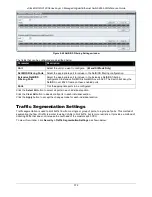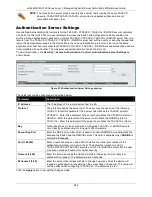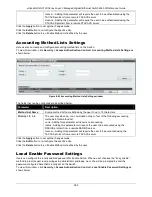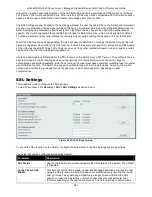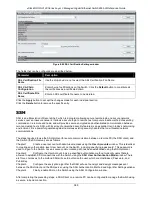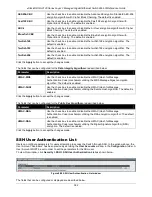
xStack® DGS-3120 Series Layer 3 Managed Gigabit Ethernet Switch Web UI Reference Guide
377
•
Extended TACACS (XTACACS)
- An extension of the TACACS protocol with the ability to provide more
types of authentication requests and more types of response codes than TACACS. This protocol also uses
UDP to transmit packets.
•
(Terminal Access Controller Access Control System plus
) - Provides detailed access
control for authentication for network devices. is facilitated through Authentication commands
via one or more centralized servers. The protocol encrypts all traffic between the Switch and the
daemon, using the TCP protocol to ensure reliable delivery
In order for the TACACS / XTACACS / / RADIUS security function to work properly, a TACACS /
XTACACS / / RADIUS server must be configured on a device other than the Switch, called an
Authentication Server Host and it must include usernames and passwords for authentication. When the user is
prompted by the Switch to enter usernames and passwords for authentication, the Switch contacts the TACACS /
XTACACS / / RADIUS server to verify, and the server will respond with one of three messages:
The server verifies the username and password, and the user is granted normal user privileges on the Switch.
The server will not accept the username and password and the user is denied access to the Switch.
The server doesn't respond to the verification query. At this point, the Switch receives the timeout from the server
and then moves to the next method of verification configured in the method list.
The Switch has four built-in Authentication Server Groups, one for each of the TACACS, XTACACS,
and RADIUS protocols. These built-in Authentication Server Groups are used to authenticate users trying to access
the Switch. The users will set Authentication Server Hosts in a preferable order in the built-in Authentication Server
Groups and when a user tries to gain access to the Switch, the Switch will ask the first Authentication Server Hosts
for authentication. If no authentication is made, the second server host in the list will be queried, and so on. The
built-in Authentication Server Groups can only have hosts that are running the specified protocol. For example, the
TACACS Authentication Server Groups can only have TACACS Authentication Server Hosts.
The administrator for the Switch may set up six different authentication techniques per user-defined method list
(TACACS / XTACACS / / RADIUS / local / none) for authentication. These techniques will be listed in an
order preferable, and defined by the user for normal user authentication on the Switch, and may contain up to eight
authentication techniques. When a user attempts to access the Switch, the Switch will select the first technique
listed for authentication. If the first technique goes through its Authentication Server Hosts and no authentication is
returned, the Switch will then go to the next technique listed in the server group for authentication, until the
authentication has been verified or denied, or the list is exhausted.
Users granted access to the Switch will be granted normal user privileges on the Switch. To gain access to
administrator level privileges, the user must access the
Enable Admin
window and then enter a password, which
was previously configured by the administrator of the Switch.
NOTE:
TACACS, XTACACS and are separate entities and are not compatible. The Switch
and the server must be configured exactly the same, using the same protocol. (For example, if
the Switch is set up for TACACS authentication, so must be the host server.)
Enable Admin
Users who have logged on to the Switch on the normal user level and wish to be promoted to the administrator
level can use this window. After logging on to the Switch, users will have only user level privileges. To gain access
to administrator level privileges, the user will open this window and will have to enter an authentication password.
Possible authentication methods for this function include TACACS/XTACACS//RADIUS, user defined
server groups, local enable (local account on the Switch), or no authentication (none). Because XTACACS and
TACACS do not support the enable function, the user must create a special account on the server host, which has
the username "enable", and a password configured by the administrator that will support the "enable" function. This
function becomes inoperable when the authentication policy is disabled.
To view this window, click
Security > Access Authentication Control > Enable Admin
as shown below:
Содержание xStack DGS-3120 Series
Страница 1: ......










